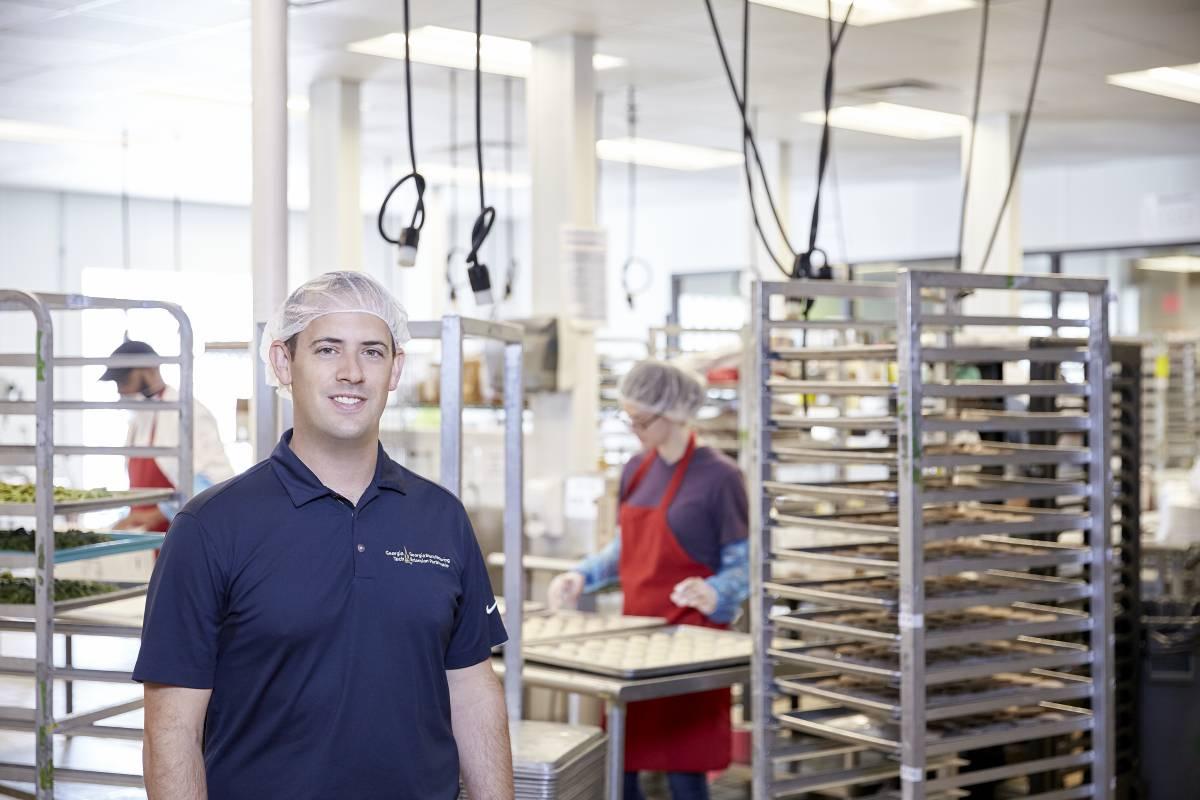For the state’s food manufacturers, a Georgia Tech partnership is the secret ingredient to growth

You would expect a building where vinegar is made to have a sour smell, highly pungent, perhaps with a whiff of apple. World Technology Ingredients (WTI) smells nothing like this. Their manufacturing facility, off a county two-lane in Jefferson, Georgia, has a vaguely mineral aroma. More dry than dank, and not altogether unpleasant.
Maybe that’s because the vinegar made here isn’t destined for grocery store shelves, but for food preservation. It’s called buffered vinegar, an all-natural additive that protects meats and other products from microbes. WTI makes a lot of this vinegar, more than they used to in fact, and that’s partly because of Damon Nix.

On this Friday afternoon, Nix is taking a visitor through WTI’s plant, pointing out its sectors and stations. Here’s the wet vinegar, seven titanic tanks and even more smaller ones, emitting a hiss-and-motor chorus of mechanized blending. Over here’s the powdered version, mixed in towering contraptions on chalky floors (that will later be cleaned), then heated, blended and bagged.
Nix stops at a white board with dry-erase markings that tell another story of what’s going on inside the plant — one of continuous improvement. Sketched out are five days of the work week, four areas of focus (safety, performance, schedule, issues) and an assortment of metrics. One of WTI’s workers happens by, and after glancing at the white board, Nix congratulates him.
“I think y’all are doing great,” he says. “These are good numbers.”
Nix doesn’t work for WTI. He’s an industry manager for the Georgia Manufacturing Extension Partnership, or GaMEP, a Georgia Tech-based, engineering-centric program that helps small and mid-sized manufacturing companies in the state perform better. As the partnership’s food and beverage point person, Nix applies his industrial engineering education from Tech to help manufacturers up their game and lower their costs.
“What I really do is facilitate problem solving,” says Nix (B.S., ISyE, ’01). He is careful to emphasize the facilitation part. He doesn’t arrive as the dreaded efficiency expert, handing down mandates and new processes to those on the floor. Rather, he operates as the quintessential engineer — conducting research, listening to people, and fostering ownership of change. When he introduces new knowledge, such as time-tested principles of lean manufacturing and quality control, it’s more as a coach guiding a player who’s motivated to improve.
“In organizations that really succeed, teams are empowered by top management,” he says. “The team has to own the process. I could go to a meeting and offer a bunch of ideas, but half of them wouldn’t be nearly as good as what people inside the company put forward and act on.”
Rise of an engineering partnership
Georgia Tech has been in the game of helping small and mid-sized manufacturers for a long time. A century ago, the idea of creating an engineering counterpart to America’s agricultural experiment stations was being debated in Congress. But the Georgia General Assembly didn’t wait for the debate to conclude — it voted in 1919 to launch an “engineering experiment station” (EES) at Georgia Tech.
Curiously, lawmakers didn’t fund the new enterprise. It wasn’t until 1934, midway through the Great Depression, that EES got its first state allocation of $5,000 and was assigned an acting director, Harry Vaughn, who described the experiment station as “Georgia's first agency designed to aid in a comprehensive development of industry.”
In 1960, the General Assembly ratcheted up Georgia Tech’s assistance to industry, passing a bill to form an Industrial Extension Service as part of the earlier EES. That authorized Georgia Tech to create field offices around the state to provide “technical advice and assistance to local development groups and to establish(ed) business and industry.” The new service was the forerunner of today’s GaMEP. The partnership sharpened its focus on manufacturing in 1988 after Congress passed a national program, the Hollings Manufacturing Extension Partnership. The Industrial Extension Service was later designated GaMEP as one of 70 MEP affiliates. (EES, by the way, later became GTRI, the Georgia Tech Research Institute.)
GaMEP, which turns 60 next year, is today housed inside Georgia Tech’s Enterprise Innovation Institute — a good fit, given its economic development focus. With 10 offices throughout Georgia, it now has a solid track record of helping small and mid-sized manufacturers grow. One of these is Dalton-based Precision Products, which manufactures a wide range of parts to order and has achieve two crucial ISO certifications that opened the door to new customers and industries. Sales grew by more than $3.5 million. And Goldens’ Foundry and Machine Co., a 130-year-old enterprise, wanted to strengthen employee communication and problem solving. GaMEP helped them introduce a management system designed to bring company conversations to the plant floor and improve information flow.


Packaging insight into food processing
One area historically underserved by GaMEP is the food and beverage industry. “It’s the state’s top manufacturing sector,” Nix says, “yet it had not been our number one customer.” So, in 2016, he was assigned to develop an initiative to broaden and deepen partnerships with businesses in the industry.
Driving much of the food and beverage industry’s growth in Georgia are companies of 50 or fewer employees. These are the makers of local craft beers, hometown jellies and artisan mustards. Nix says about eight of 10 food processing companies fit that size profile, though they are dwarfed in sales by the other 20 percent, the larger manufacturers.
So he developed a market analysis and concluded that super-sizing a commitment to food and beverage would be a good fit. The demand was there, too. Food processing employs nearly 70,000 Georgians and accounts for $12 billion of the state’s GDP every year, according to a 2016 report from Georgia Power. Since GaMEP stepped up efforts to serve the industry in 2017, the average number of projects with food and beverage companies more than doubled, from 20 to 45.
When asked to describe the greatest problems facing these manufacturers, Nix quickly cites compliance with safety regulations, which, to a small food business, run from complex to bewildering. “If you’re in a business of 10 to 20 people, you may not have a food scientist on staff,” he says. “So, you’ve got to figure out compliance on your own, or else bring in consultants.”
Safety, he notes, is more than just following protocols in production. It involves attending to details in reporting and paperwork, all the way down to the product label. Nix shares the cautionary tale of an Oregon maker of seasonings that neglected to include hazelnuts in its list of ingredients on the label. “Of course, nut allergies are a huge issue,” he says. “That one mistake could have ruined their entire product distribution. The damage to the brand, and the cost of bringing back the brand, is so significant.”
While GaMEP knew it could help food companies in an array of ways — from process management to energy usage to business growth — leaders found they had a gap in food science expertise. Food science determines the safety profile of every jar, tin, box and bag of product. So they brought in a food manufacturing safety whiz, Wendy White, who had experience overseeing a portfolio of food products. White is now leading a new GaMEP program on safety, funded by a three-year grant totaling nearly $1 million.
For the ingredients company WTI, the primary challenge has not been safety but improving processes and efficiency. When asked what impact he’s seen from GaMEP’s help, Stephan Georg, the company’s director of strategic sourcing, recounts a conversation between a shift foreman and consultant in front of one of the Gemba white boards.
“The foreman said the plan was to make two batches of a product,” Georg says, “but the consultant answered, ‘Well, I think you can do five batches. The foreman thought that was unrealistic. So we brought in Georgia Tech, and the first thing Damon does is conduct time studies. It gave us that baseline information we needed. After that groundwork, we determined that three batches would be a good goal.”
Since then, Nix has visited with workers from WTI’s round-the-clock shifts and consulted with management. Together, they work through improvements born out of lean manufacturing, which are processes engineered to reduce waste and improve customer satisfaction. The goal is to reach 40 percent overall equipment effectiveness for producing buffered vinegar, a metric built on several components of the manufacturing process.
More recently, Nix introduced a new tool to these efforts: A software platform called Impruver, developed out of Georgia Tech’s Advanced Technology Development Center (ATDC). It’s designed to help small and mid-sized manufacturers of consumer products spot trends in metrics, track performance and monitor ongoing issues. “It’s great to have another entity inside ATDC working with us and our clients,” Nix says.
While all of GaMEP’s contributions are welcomed, Stephan Georg has special praise for the non-engineering side of Damon Nix. “While he looks at the facts and explains things in a scientific way, he also treats people here with respect,” Georg says. “They see that he’s not here to get them fired. He’s the guy who’s here to help.”